An Experimental Study on Compressive Strength of Fiber Reinforced Concrete With Fly Ash
Er.Balvir Singh, Structural Engineer Futura Design Consultants Pvt. Ltd. Ludhiana, Dr.Jaspal Singh, Professor, Deptt. Of Civil Engineering Punjab Agricultural University, Ludhiana
This paper deals with an experimental study on the properties of concrete containing fly ash and fibers. Fly ash content used was 0%, 3%, 9% and 12% of mass basis, and fiber volume fraction was 0%, 0.75%, 1%, 1.25% and 1.5% of volume basis. The experiment conducted show, that steel fiber addition, either into Portland cement concrete or Fly ash concrete, improves the tensile strength and drying shrinkage and decreases workability. Although Fly ash replacement reduces strength properties, it improves workability, reduces drying shrinkage and increases freeze–thaw resistance of fiber reinforced concrete. The performed experiments show that the behavior of Fly ash concrete is similar to that of Portland cement concrete when fly ash is added. In the proposed experimental investigation, the behavior of fiber reinforced concrete with Fly ash as a admixture is studied in compression with the objective to determine the:
Fly ash is the fine powder produced as a product from the combustion of pulverized coal. The disposal of fly ash is one of the major issues as dumping of fly ash as a waste material may cause severe environmental problems. Therefore, the utilization of fly ash as an admixture in concrete instead of dumping it as a waste material can have great beneficial effects of lowering the water demand of concrete for similar workability, reduced bleeding and lowering evolution of heat. The use of fly ash in concrete is found to affect strength characteristics adversely. One of the ways to compensate for the early-age strength loss associated with the usage of fly ash is by incorporating fibers. Islam M et al reported that the addition of fibers to concrete considerably improves its structural characteristics such as static flexural strength, impact strength, tensile strength, ductility and flexural toughness. Generally, aspect ratios of steel fibers used in concrete mix are varied between 50 and 100. The most suitable volume fraction values for concrete mixes are between 0.5% and 2% by volume of concrete. In general, the character and performance of fiber reinforced concrete changes with varying concrete formulation as well as material geometry distribution, orientation and concentration of fiber.
Cement: The most commonly used cement in concrete is Ordinary Portland Cement. Concrete made with this cement is tested for strength after a curing (and hydration) period of 28 days.
Fly Ash: The Fly ash obtained is finer than Portland cement but contains less oxide as compared to Portland cement. The carbon content in fly ash should be as low as possible, whereas the silicon content should be as high as possible. The fly ash may be used in concrete either as an admixture or in part replacement of cement. The pozzolanic activity is due to the presence of finely divided glassy silica and lime, which produce calcium silicate hydrate responsible for strength development.
Aggregates: The aggregates used in plain concrete are suitable for fiber reinforced concrete. The aggregates are normally divided in two categories, namely fine and coarse. Fine aggregate normally consists of natural, crushed, or manufactured sand. In some instances, manufactured lightweight particles are used for lightweight concrete or mortar. Heavy weight particles made of metallic component are sometimes used to produce heavy weight concrete for nuclear shielding purposes. The maximum grain size and size distribution depends on the type of product being manufactured. Coarse aggregates can be normal weight, lightweight, or heavy weight in nature, even though heavy weight aggregate usage is very limited. Normal weight coarse aggregates can be made of natural gravel or crushed stone. Lightweight coarse aggregates are normally made of expanded clay (such as shale or pumice) or blast furnace slag.
Fibers: The most important parameter describing a fiber is its Aspect ratio. "Aspect ratio" is the length of fiber divided by an equivalent diameter of the fiber, where equivalent diameter is the diameter of the circle with an area equal to the cross sectional area of fiber. The properties of fiber reinforced concrete are very much affected by the type of fiber. Different types of fibers which have been tried to reinforce concrete are steel, carbon, asbestos, vegetable matter, polypropylene and glass. In present experimental study, steel fiber of 26 SWG has been used with aspect ratio of 80.

Fine Aggregates: Locally available river sand was used as Fine Aggregate. Sieve Analysis of the fine aggregate was carried out in the laboratory as per IS 383 and tested as per IS 2386 as shown in Table 2.
Coarse Aggregate: Locally available crushed coarse aggregate was used. Sieve Analysis of the coarse aggregate was carried out in the laboratory as per IS 383 and tested as per IS 2386 as shown in Table 3.
Water: According to IS 3025, water to be used for mixing and curing should be free from injurious or deleterious materials. Potable water is generally considered satisfactory. In the present investigation, tap water was used for both mixing and curing purposes.
Fly Ash: Fly ash used in the experiments is taken from Guru Gobind Singh Thermal Plant, Ropar. Physical properties are checked in laboratory and the chemical properties are reported here for ready reference as obtained from GGS Thermal Plant. The physical properties and chemical properties of fly ash are given in Table 4.
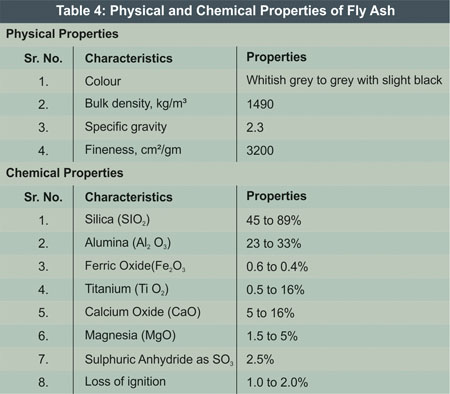
Steel Fibers: Black Annealed mild steel fibers of 26 SWG (average diameters 0.46 mm) were used. The aspect ratio of fiber was kept as 80. The physical properties of fibers are given in Table 5.

Concrete Mix Design and Casting of Specimen: M-20 Concrete mix was used with 10 mm coarse aggregate. The Concrete Mix Design was carried out based on Indian Standard Guidelines. The relation between various constituents arrived at was 1: 1.3: 2.3 respectively by weight and water cement ratio of 0.57. Effectiveness of fibers in the concrete is related among other factors to the 'aspect-ratio' and volume percentages of the fibers, size, gradation, quality of the coarse aggregate and water cement ratio. Increase in the aspect ratio, volume percentage of fibers, coarse aggregate size, gradation and quality intensifies balling of fibers. For uniform mixing and to prevent the 'balling' the aspect ratio of round wires was kept as 80. Volume fraction of steel fibers was taken as 1.5% as beyond that these were difficult to mix. The annealed mild steel wires were cut in lengths of 3.68 cm to have aspect ratios of 80. Care was taken for prevention of fiber balls. Required proportion of coarse aggregate, Fine Aggregate and Cement were mixed with trowels and spade until a homogeneous mix was obtained. The fibers were weighted; half of the fibers were sprinkled by hand from the top by one person while the other person kept mixing them in the dry mix. Then water was slowly added and mixture was thoroughly mixed. The remaining fibers were again sprinkled and same process was repeated. The mould was cast in 3 layers. Table vibrator was used for compaction. It was most suitable, as the fibers tend to align themselves in the plane perpendicular to the direction of vibration. This gives random planar orientation. The top surface of the specimen was smoothened with help of wooden float.
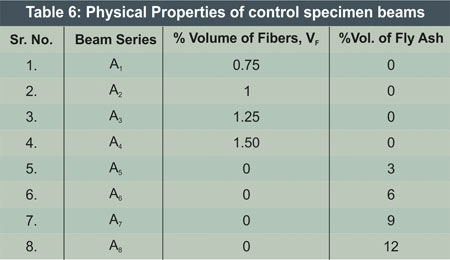
Experimental Programme: In the present investigation cubes having size 15 cm x15 cm x15 cm were tested to failure. The cubes were designated as A (1–8), B, C, D, E, F, G, H, I, J, K, L, M, N, O, P and Q. These cubes had varying percentages of fiber by volume with constant aspect ratios of 80. The details of the cubes are given in Table 6. The properties of control specimen are described in Table 7 with 0% fly ash and different volume fraction of fibers and 0% fibers and different volume of fly ash. The different percentages of fibers used were 0.75%, 1.0% 1.25% & 1.5%. The aspect ratio of the steel fibers used was 80. The difference percentage fly ash used was 3%, 6%, 9% & 12%.After de-moulding the specimen, the cubes were allowed to dry for one day before placing them in the curing tank for a period of 27 days.
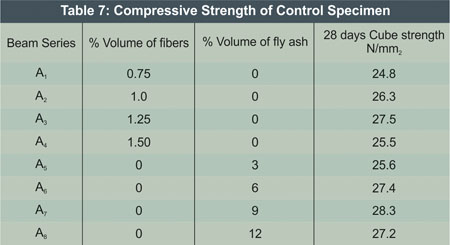
The result of tests on Auxiliary specimens is given in Table 8 and graphical representation is given in Figure 1 & Figure 2. It is observed that the compressive strength of the auxiliary specimen increased with the increase in Fiber Content and Fly ash. The cube 'K 'with a fiber percentage of 1.25% and 6% fly ash showed ultimate strength of 37.67 N/mm2, which is about 37% more than 'A1' and 33% more than 'A2.'The compressive strength of cubes reduced, when volume fraction of the fibers used was 1.5% and fly ash 12%, which may be due to balling of fibers.
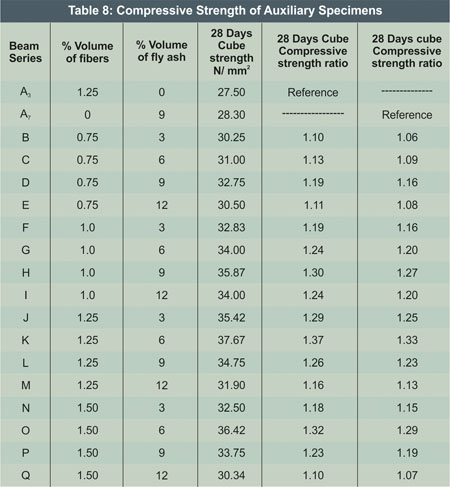
This paper deals with an experimental study on the properties of concrete containing fly ash and fibers. Fly ash content used was 0%, 3%, 9% and 12% of mass basis, and fiber volume fraction was 0%, 0.75%, 1%, 1.25% and 1.5% of volume basis. The experiment conducted show, that steel fiber addition, either into Portland cement concrete or Fly ash concrete, improves the tensile strength and drying shrinkage and decreases workability. Although Fly ash replacement reduces strength properties, it improves workability, reduces drying shrinkage and increases freeze–thaw resistance of fiber reinforced concrete. The performed experiments show that the behavior of Fly ash concrete is similar to that of Portland cement concrete when fly ash is added. In the proposed experimental investigation, the behavior of fiber reinforced concrete with Fly ash as a admixture is studied in compression with the objective to determine the:
- Optimum value of volume friction of steel fiber for constant value of Aspect ratio and Constant percentage of fly ash replacement with cement.
- Optimum value of percentage of fly ash replacement with cement for the Constant fiber parameter, i.e. Aspect ratio and volume friction
- Post cracking behavior of fiber reinforced concrete.
Introduction
Concrete is currently the most widely used construction material as it can be cast to any form and shape at site very easily. However, the relative low tensile strength to weight ratio and limited ductility of plain cement concrete poses major difficulty in its direct applications. To overcome these deficiencies, reinforcing of tensile zone with steel bars and prestressing of plain cement concrete has been invariably used. But all these measures do not improve the post cracking behavior of concrete. In fiber reinforced concrete, short discontinuous fibers are added to plain and reinforced concrete to improve the post cracking behavior and tensile strength to weight ratio.Fly ash is the fine powder produced as a product from the combustion of pulverized coal. The disposal of fly ash is one of the major issues as dumping of fly ash as a waste material may cause severe environmental problems. Therefore, the utilization of fly ash as an admixture in concrete instead of dumping it as a waste material can have great beneficial effects of lowering the water demand of concrete for similar workability, reduced bleeding and lowering evolution of heat. The use of fly ash in concrete is found to affect strength characteristics adversely. One of the ways to compensate for the early-age strength loss associated with the usage of fly ash is by incorporating fibers. Islam M et al reported that the addition of fibers to concrete considerably improves its structural characteristics such as static flexural strength, impact strength, tensile strength, ductility and flexural toughness. Generally, aspect ratios of steel fibers used in concrete mix are varied between 50 and 100. The most suitable volume fraction values for concrete mixes are between 0.5% and 2% by volume of concrete. In general, the character and performance of fiber reinforced concrete changes with varying concrete formulation as well as material geometry distribution, orientation and concentration of fiber.
Materials and Methods
Properties of Constituent Materials: The components of fly ash fiber reinforced composites are the matrix and the fiber. The matrix generally consists of Portland cement, fly ash, coarse aggregates, fine aggregate, water and fibers.Cement: The most commonly used cement in concrete is Ordinary Portland Cement. Concrete made with this cement is tested for strength after a curing (and hydration) period of 28 days.
Fly Ash: The Fly ash obtained is finer than Portland cement but contains less oxide as compared to Portland cement. The carbon content in fly ash should be as low as possible, whereas the silicon content should be as high as possible. The fly ash may be used in concrete either as an admixture or in part replacement of cement. The pozzolanic activity is due to the presence of finely divided glassy silica and lime, which produce calcium silicate hydrate responsible for strength development.
Aggregates: The aggregates used in plain concrete are suitable for fiber reinforced concrete. The aggregates are normally divided in two categories, namely fine and coarse. Fine aggregate normally consists of natural, crushed, or manufactured sand. In some instances, manufactured lightweight particles are used for lightweight concrete or mortar. Heavy weight particles made of metallic component are sometimes used to produce heavy weight concrete for nuclear shielding purposes. The maximum grain size and size distribution depends on the type of product being manufactured. Coarse aggregates can be normal weight, lightweight, or heavy weight in nature, even though heavy weight aggregate usage is very limited. Normal weight coarse aggregates can be made of natural gravel or crushed stone. Lightweight coarse aggregates are normally made of expanded clay (such as shale or pumice) or blast furnace slag.
Fibers: The most important parameter describing a fiber is its Aspect ratio. "Aspect ratio" is the length of fiber divided by an equivalent diameter of the fiber, where equivalent diameter is the diameter of the circle with an area equal to the cross sectional area of fiber. The properties of fiber reinforced concrete are very much affected by the type of fiber. Different types of fibers which have been tried to reinforce concrete are steel, carbon, asbestos, vegetable matter, polypropylene and glass. In present experimental study, steel fiber of 26 SWG has been used with aspect ratio of 80.
Results and Discussions
Cement: Locally available ordinary Portland Cement (OPC) 43 Grade was used in the present investigation. This Cement satisfied nearly all the requirements of the IS 8112 and IS 1489. The different properties of the Cement tested in the laboratory are listed in Table 1.
Fine Aggregates: Locally available river sand was used as Fine Aggregate. Sieve Analysis of the fine aggregate was carried out in the laboratory as per IS 383 and tested as per IS 2386 as shown in Table 2.
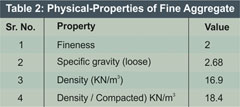 |
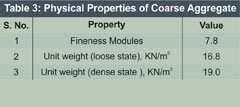 |
Coarse Aggregate: Locally available crushed coarse aggregate was used. Sieve Analysis of the coarse aggregate was carried out in the laboratory as per IS 383 and tested as per IS 2386 as shown in Table 3.
Water: According to IS 3025, water to be used for mixing and curing should be free from injurious or deleterious materials. Potable water is generally considered satisfactory. In the present investigation, tap water was used for both mixing and curing purposes.
Fly Ash: Fly ash used in the experiments is taken from Guru Gobind Singh Thermal Plant, Ropar. Physical properties are checked in laboratory and the chemical properties are reported here for ready reference as obtained from GGS Thermal Plant. The physical properties and chemical properties of fly ash are given in Table 4.

Steel Fibers: Black Annealed mild steel fibers of 26 SWG (average diameters 0.46 mm) were used. The aspect ratio of fiber was kept as 80. The physical properties of fibers are given in Table 5.

Concrete Mix Design and Casting of Specimen: M-20 Concrete mix was used with 10 mm coarse aggregate. The Concrete Mix Design was carried out based on Indian Standard Guidelines. The relation between various constituents arrived at was 1: 1.3: 2.3 respectively by weight and water cement ratio of 0.57. Effectiveness of fibers in the concrete is related among other factors to the 'aspect-ratio' and volume percentages of the fibers, size, gradation, quality of the coarse aggregate and water cement ratio. Increase in the aspect ratio, volume percentage of fibers, coarse aggregate size, gradation and quality intensifies balling of fibers. For uniform mixing and to prevent the 'balling' the aspect ratio of round wires was kept as 80. Volume fraction of steel fibers was taken as 1.5% as beyond that these were difficult to mix. The annealed mild steel wires were cut in lengths of 3.68 cm to have aspect ratios of 80. Care was taken for prevention of fiber balls. Required proportion of coarse aggregate, Fine Aggregate and Cement were mixed with trowels and spade until a homogeneous mix was obtained. The fibers were weighted; half of the fibers were sprinkled by hand from the top by one person while the other person kept mixing them in the dry mix. Then water was slowly added and mixture was thoroughly mixed. The remaining fibers were again sprinkled and same process was repeated. The mould was cast in 3 layers. Table vibrator was used for compaction. It was most suitable, as the fibers tend to align themselves in the plane perpendicular to the direction of vibration. This gives random planar orientation. The top surface of the specimen was smoothened with help of wooden float.

Experimental Programme: In the present investigation cubes having size 15 cm x15 cm x15 cm were tested to failure. The cubes were designated as A (1–8), B, C, D, E, F, G, H, I, J, K, L, M, N, O, P and Q. These cubes had varying percentages of fiber by volume with constant aspect ratios of 80. The details of the cubes are given in Table 6. The properties of control specimen are described in Table 7 with 0% fly ash and different volume fraction of fibers and 0% fibers and different volume of fly ash. The different percentages of fibers used were 0.75%, 1.0% 1.25% & 1.5%. The aspect ratio of the steel fibers used was 80. The difference percentage fly ash used was 3%, 6%, 9% & 12%.After de-moulding the specimen, the cubes were allowed to dry for one day before placing them in the curing tank for a period of 27 days.

The result of tests on Auxiliary specimens is given in Table 8 and graphical representation is given in Figure 1 & Figure 2. It is observed that the compressive strength of the auxiliary specimen increased with the increase in Fiber Content and Fly ash. The cube 'K 'with a fiber percentage of 1.25% and 6% fly ash showed ultimate strength of 37.67 N/mm2, which is about 37% more than 'A1' and 33% more than 'A2.'The compressive strength of cubes reduced, when volume fraction of the fibers used was 1.5% and fly ash 12%, which may be due to balling of fibers.

Conclusion
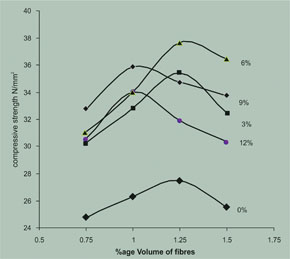 |
| Figure 1: Variation in 28 days compressive strength at different percentage volume of fibres |
- The optimum value of fly-ash replacement and volume fraction of fibers in concrete mix was found to be 6% and 1.25% respectively.
- Stiffness of nearly all the cubes was increased due to fly-ash and fiber addition in concrete mix.
- Post-cracking strength of all the cubes increased significantly.
References:
- Alguire C. (1987) 'Steel Fibers as Shear Reinforcement in reinforced concrete T beams.' Proceedings of International Symposium on Fiber Reinforced Concrete Dec.pp16-19, Madras.
- Anderson, B.G. (1957) 'Rigid beams failures' ACI Journal, Proc. V. 53 No. 7, pp. 625-636.
- Kukerja C.B.(1991) 'Structural characteristics of Fiber Reinforced Concrete' Ph. D.Thesis, University of Roorkee,
- Batra V.S. Kukreja C.B. (1994) 'The Effect of Steel Fibers on enhancing the life of concrete structures', National Seminar on Fiber Reinforced Concrete, Jan., 28-29, pp. 339-345.
- Snyder, M.J. and Landard, D.R (1972) "Factor affecting the Flexural Strength of Steel Fibrous Concrete," Journal of A.C.I., Proceedings Vol. 69, No. 2, Feb.
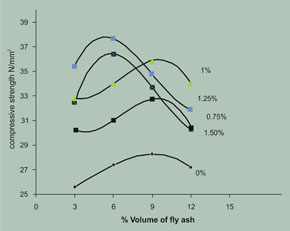
Figure 2: Variation in 28 days compressive strength at different percentage volume of fly ash - Swamy, R.N. and Mangat, P.S (1974)," A theory for the Flexural Strength of steel fiber reinforced concrete," Magazine of cement and concrete research, vol. 4, No.2, March, pp. 313-315.
- Pakotiprabha, B., R.P. and Lee, S.L (1974) "Mechanical properties of cement mortar with randomly oriented short steel wires," Magazine of Concrete research, Vol. 26, No. 86, March, pp.3-15.
- Walkuz, B.R., Januszkiewicz, A. and Jeuzal, J.,(1979) "Concrete composite with cut steel Fiber reinforcement subjected to uniaxial tension," Journal of the American Concrete Institute, Vol. 76. October, pp 1079-1092.
- Kukreja, C.B., Kaushik, S.K., Kanchi, M.B. and Jain, O.P.(1980) "Flexural characteristic of Steel Fiber reinforced concrete," Indian Concrete Journal, July, pp. 184-188.
- Haque, M.N., et al.,(1984) " High Fly Ash Concrete," ACI Journal, January- February, pp. 56-60.
- Islam M. A Fiqual and Alam, A.K.M. Khorshed,(1987) "Study of Fiber Reinforced Concrete with natural Fibers. "Proceedings of the International Symposium on Fiber Reinforced Concrete December 16-19, Madras, India.
- Chitharanjan, N.(1996) "Feasibility study of using Fly Ash concrete for reinforced flexural members," The Indian Concrete Journal September, pp. 503-508.
- Sabapathi, P. and Achyutha, H.(1989)" Analysis of Steel Fiber Reinforced Concrete Beams," Indian Concrete Journal May, pp. 246-252.
- Dwarakanath, H.V. and Naraj, T.S.(1992) "Deformational behavior of Reinforced Fiber Concrete beams in Bending," Journal of Structural Engg., ASCE, Vol. 118, No. 10. October pp 2697-2698.
- Syed Entesham Hussain and asheeduzzafar, (1994)" Corrosion resistance performance of Fly Ash blended cement concrete," ACI Material Journal, May – June, pp 264-272.
- Malhotra, V.M., Garette, G. G., and Bilodeau, A.(1994) 'Mechanical properties and durability of polypropylene Fibers Reinforced High-Volume Fly Ash Concrete for shortcrete applications' ACI Materials Journal, Sept-Oct 1994, Vol. 91, No. 5, pp 478-486.
- Z. Bayasi and P. Soroushian (1989) 'Optimum use of pozzolanic materials in steel fiber reinforced concrete' Transportation Research Record, No. 1226, pp 25-30.
- R.K. Sharma, C. S. Pant, &R.K. Ghosh,(1975) 'Estimation of Fly Ash content in cement–fly ash mortar' ISI-Bulletin- Vol. 27, March, PP –24-28.
- IS-516, (1959) 'Indian Standards methods of tests for strength of concrete'
- IS-383, (1870) 'Specification for Coarse and Fine Aggregate from natural source of concrete'
- IS-2386, (1963) 'Methods for test for Aggregates for concrete'
- IS-8112, (1989) 'Grade-43 –Ordinary Portland cements Specification'
- IS-1489, (1991) 'Portland Pozzolana Cement Specification'
- IS-3025, (1983) 'Method of sampling and test for water and waste water'
NBM&CW October 2010


















